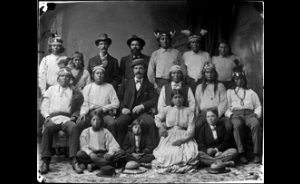talking history | syllabi | students | teachers | puzzle | about us
Shadows at Dawn
http://brown.edu/Research/Aravaipa/
Created and maintained by faculty, staff, and students, Brown University, Providence, RI.
Reviewed Aug.–Oct. 2010.
The Shadows at Dawn Web site is a collective online project hosted by Brown University that serves as an innovative compliment to Karl Jacoby’s monograph Shadows at Dawn: A Borderlands Massacre and the Violence of History (2008). At the heart of both the monograph and the site is the Camp Grant massacre of 1871 in Arizona Territory, where a group of Anglo-American, Mexican American, and Tohono O’odham men murdered approximately 140 Apaches who were encamped near the Camp Grant army base. The accused were brought to trial and acquitted of any wrongdoing. Interestingly, Apache victims and eyewitnesses were denied their place in the court proceedings. Jacoby’s study and the site fill that void. Infused in the greater narrative are oral histories from each of the major ethnic groups involved in the incident, copies of land titles placing the major actors involved, and transcripts of the court proceedings and informal negotiations between American officials and the Apaches. Moreover, the interdisciplinary nature of the site includes detailed discussion of Native American linguistics, sociological differences between the major ethnic groups in the region, and topographical descriptions reflects the complexity of the event and Jacoby’s methodology.

Apache Delegation from San Carlos.
Shadows at Dawn presents a comprehensive overview of the massacre while providing a sharp lens onto the event, the place, and the people involved. The historical narrative is complimented by several links to primary sources that appear at almost every turn. The home page is designed with a simple yet effective layout that dissects the event into seven categories “The Event,” "The Trial,“ "The Peoples,” "The Places,“ "The Treaty,” "The Present,“ and ”The Documents." The first five categories focus on the massacre and contain hyperlinked sources within the narrative that lead to maps, an expanded explanation of key terms and events, court transcripts, and other primary documents.
Arguably the richest resource available on the site is the category “The Peoples.” Here the user is able to understand and learn more about the various ethnic groups involved in the incident. Anglo-Americans, Mexican Americans, Tohono O’odham, and the Apaches are given individual attention, and a comprehensive overview of their history in the area beyond the Camp Grant massacre is also provided. The user has access to a variety of digitized resources that include oral histories, land grant documents, transcripts of political negotiations, as well as ethnographical information.
The final two categories, “The Present” and “The Documents,” provide links to online archives, databases, classroom lesson plans, and an index to the numerous documents used in the site as a quick reference tool. Four detailed lesson plans and activities are available for use by secondary and higher education instructors. Links to several online archives such as Arizona-Sonora Documents Online and the Hayden Arizona Pioneer Biographies Collection expand the capabilities of this invaluable resource. In addition, a multitude of regional museums and historic sites are hyperlinked from the site.
Shadows at Dawn easily and affectively combines a lively and well-researched narrative with the accessibility of digitized sources. The site augments the resourcefulness of the historical narrative.
Miguel A. Levario
Texas Tech University
Lubbock, Texas
